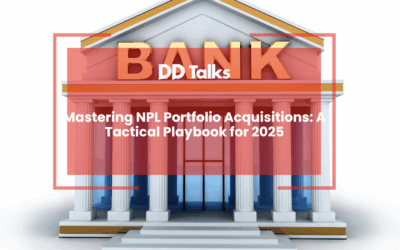Key Takeaways
- The European NPL market is evolving with projected surges in Southern Europe and emerging opportunities in Central and Eastern European markets, requiring investors to develop specialized expertise across multiple sectors.
- Effective NPL due diligence requires a comprehensive framework including loan-level data analysis, collateral valuation, legal verification, and forward-looking scenario modeling enhanced by AI-driven tools.
- Advanced valuation techniques now incorporate probability-weighted scenarios, Monte Carlo simulations, and machine learning algorithms to provide more nuanced understanding of expected returns on distressed debt assets.
- Key risk factors in NPL portfolio management include servicing quality, legal and regulatory challenges, market dynamics, documentation issues, and reputational concerns that vary significantly across jurisdictions.
- European legal frameworks for NPL resolution differ substantially despite harmonization efforts, with enforcement timelines ranging from under one year to over five years depending on jurisdiction.
- Strategic exit planning should incorporate multiple options including securitization, portfolio refinancing, property conversion, and forward flow arrangements tailored to specific asset characteristics.
- Co-investment structures like joint ventures, club deals, and specialized platforms offer advantages beyond capital aggregation, including risk diversification, knowledge sharing, and operational efficiency.
- Future NPL market trends include potential new waves of formation due to elevated interest rates, technological transformation through AI applications, and emerging opportunities in secondary markets and the UTP segment.
Table of Contents
- Understanding the NPL Investment Landscape in 2025
- Essential NPL Due Diligence: Building a Robust Framework
- Advanced Valuation Techniques for Distressed Debt Assets
- What Are the Key Risk Factors in NPL Portfolio Management?
- Navigating Legal Frameworks Across European NPL Markets
- Strategic Exit Planning: Maximizing NPL Investment Returns
- Leveraging Co-Investment Structures for Enhanced Outcomes
- Future Trends: NPL Market Outlook and Emerging Opportunities
Understanding the NPL Investment Landscape in 2025
The European non-performing loan (NPL) market continues to evolve rapidly as we approach 2025, presenting both challenges and opportunities for distressed debt investors. Current projections indicate a potential surge in NPL volumes across several key European markets, driven by the lingering economic effects of recent global disruptions and tightening monetary policies.
Southern European countries, particularly Italy, Greece, and Spain, remain significant NPL hubs with substantial transaction volumes. However, emerging opportunities are developing in Central and Eastern European markets where banking systems are undergoing structural reforms. The NPL ratio disparities across Europe create a diverse investment landscape, with some markets offering higher-yield opportunities balanced against elevated risk profiles.
Notably, the asset class composition is shifting, with an increasing proportion of corporate and SME loans entering NPL portfolios alongside the traditional residential mortgage exposures. This diversification requires investors to develop specialised expertise across multiple sectors. Additionally, the competitive landscape has intensified with the entrance of more institutional investors seeking yield in the distressed debt space, potentially compressing returns for less sophisticated market participants.
Essential NPL Due Diligence: Building a Robust Framework
Effective NPL due diligence forms the cornerstone of successful distressed debt investing. A comprehensive framework must encompass multiple dimensions of analysis to accurately assess portfolio value and risk. The foundation begins with granular loan-level data examination, scrutinising borrower profiles, payment histories, and collateral documentation. This microscopic approach reveals patterns and anomalies that aggregate statistics might obscure.
Collateral valuation represents a critical component, particularly for secured NPLs. This necessitates thorough property inspections, market comparables analysis, and consideration of liquidation timelines within specific jurisdictions. Legal due diligence must verify loan enforceability, identify documentation gaps, and assess potential challenges to recovery processes. Simultaneously, operational due diligence evaluates the existing servicing arrangements and determines whether enhancements or replacements are required.
Forward-looking scenario analysis completes the framework, modelling various economic conditions and their impact on recovery rates and timelines. This multifaceted approach to distressed investment strategies enables investors to identify hidden value opportunities while quantifying downside risks. Increasingly, successful investors are employing advanced data analytics and AI-driven tools to enhance traditional due diligence methodologies, extracting insights from unstructured data sources and identifying correlations that human analysis might miss.
Advanced Valuation Techniques for Distressed Debt Assets
Accurate valuation of distressed debt assets demands sophisticated methodologies that account for the complex nature of NPL portfolios. The discounted cash flow (DCF) approach remains fundamental, but requires refinement through probability-weighted recovery scenarios rather than single-point estimates. Modern valuation frameworks incorporate Monte Carlo simulations to model thousands of potential outcomes, providing a more nuanced understanding of expected returns and their distribution.
Comparative transaction analysis offers valuable benchmarking, though requires careful adjustment for portfolio composition, vintage, and jurisdiction-specific factors. The market approach must be supplemented with bottom-up analysis that evaluates individual loan characteristics and recovery potential. For secured NPLs, advanced collateral valuation techniques incorporate geospatial analytics and automated valuation models calibrated for distressed properties.
Increasingly, machine learning algorithms are being deployed to enhance valuation accuracy by identifying non-linear relationships between loan attributes and recovery outcomes. These models can process vast datasets to detect subtle patterns that traditional statistical approaches might miss. However, technological sophistication must be balanced with fundamental understanding of local market dynamics and legal frameworks. The most effective valuation approaches combine quantitative rigour with qualitative insights from experienced workout specialists who understand the practical challenges of NPL resolution in specific jurisdictions.
What Are the Key Risk Factors in NPL Portfolio Management?
Effective NPL portfolio management requires comprehensive risk identification and mitigation strategies across multiple dimensions. Servicing risk stands as perhaps the most significant operational challenge, as the quality of loan workout execution directly impacts recovery outcomes. Investors must carefully evaluate servicer capabilities, incentive structures, and performance monitoring frameworks to ensure alignment with portfolio objectives.
Legal and regulatory risks present formidable challenges, particularly in cross-border investments. Judicial inefficiencies, changing foreclosure regulations, and borrower protection measures can significantly extend recovery timelines and reduce ultimate recoveries. These risks vary substantially across European jurisdictions, with some countries offering streamlined enforcement processes while others present lengthy and unpredictable legal pathways.
Market risks encompass both macroeconomic factors and real estate market dynamics that influence collateral values and borrower repayment capacity. Interest rate fluctuations, employment trends, and property market liquidity all impact NPL performance. Documentation risk remains prevalent in many portfolios, with incomplete or defective loan documentation potentially undermining enforcement actions. Finally, reputational risk requires careful consideration, as aggressive recovery practices can damage investor standing and trigger regulatory scrutiny. Successful NPL portfolio management requires sophisticated risk assessment frameworks that quantify these diverse risk factors and implement targeted mitigation strategies.
Navigating Legal Frameworks Across European NPL Markets
The European NPL landscape presents a complex mosaic of legal frameworks that significantly impact investment strategies and recovery outcomes. While the European Banking Authority and European Central Bank have driven harmonisation efforts, substantial jurisdiction-specific differences persist. Southern European markets have implemented significant reforms to accelerate NPL resolution, with Italy’s GACS scheme and Greece’s Hercules programme creating securitisation frameworks that facilitate NPL transactions while providing investor protections.
Enforcement timelines represent a critical consideration, varying dramatically from under one year in some Northern European jurisdictions to over five years in certain Southern European countries. These disparities directly impact recovery rates and investment returns. Bankruptcy regimes also differ substantially, with some jurisdictions favouring creditor rights while others emphasise business continuity and borrower protection. Recent reforms in Spain, Italy and Greece have generally strengthened creditor positions, though implementation challenges remain.
Data protection regulations add another layer of complexity, with GDPR requirements imposing strict controls on borrower information handling throughout the NPL lifecycle. Successful investors develop jurisdiction-specific legal strategies that navigate these complexities while maintaining regulatory compliance. Increasingly, legal technology solutions are being deployed to streamline documentation review, automate compliance processes, and enhance recovery workflows. Understanding these nuanced legal frameworks is essential for accurate valuation and effective NPL portfolio management across European markets.
Strategic Exit Planning: Maximizing NPL Investment Returns
Sophisticated exit planning represents a critical success factor in NPL investing, requiring strategic foresight from the initial acquisition phase. The traditional “work-out and collect” approach remains viable for certain portfolio segments, but increasingly investors are implementing multi-faceted exit strategies tailored to specific asset characteristics. Securitisation has emerged as a powerful exit mechanism, particularly for larger portfolios with relatively homogeneous loan attributes. These structures can create tranched securities appealing to different investor risk appetites, potentially unlocking premium valuations.
Portfolio refinancing presents another strategic option, particularly when improved servicing and partial resolutions have enhanced portfolio performance metrics. This approach allows investors to crystallise gains while potentially retaining upside exposure through retained interests. For real estate-heavy portfolios, conversion to real estate owned (REO) followed by property refurbishment and sale can maximise value, though requires specialised asset management capabilities.
Forward flow arrangements with originating banks or other investors provide liquidity options, particularly for portfolios with extended recovery timelines. Timing considerations remain paramount, with market cycle awareness informing optimal exit windows. The most successful investors maintain flexibility in their exit strategies, continuously reassessing options as portfolio performance evolves and market conditions shift. This dynamic approach to exit planning, supported by robust data analytics and scenario modelling, enables investors to maximise risk-adjusted returns across diverse NPL portfolios.
Leveraging Co-Investment Structures for Enhanced Outcomes
Co-investment structures have emerged as sophisticated vehicles for optimising NPL investment outcomes, allowing participants to access opportunities while mitigating specific risk factors. These arrangements typically involve multiple investors pooling capital and expertise to acquire and manage distressed debt portfolios. The joint venture model represents the most common structure, with partners contributing complementary capabilities—often pairing local market expertise with international capital and workout experience.
Club deals offer another effective approach, particularly for larger transactions requiring substantial capital deployment. These structures typically involve a lead investor managing the acquisition and workout process, with co-investors participating through negotiated governance and economic arrangements. Specialised NPL investment platforms have also proliferated, creating permanent capital vehicles with dedicated management teams focused on specific market segments or jurisdictions.
The advantages of co-investment extend beyond capital aggregation. These structures facilitate risk diversification, knowledge sharing, and operational efficiency through economies of scale. They can also enhance deal sourcing through expanded relationship networks and create competitive advantages in auction processes. However, successful implementation requires careful structuring of governance mechanisms, aligned incentives, and clear decision-making protocols. Investors must negotiate detailed agreements addressing control rights, information sharing, exit mechanisms, and dispute resolution procedures. When properly structured, these co-investment arrangements can significantly enhance risk-adjusted returns while expanding the universe of accessible NPL opportunities.
Future Trends: NPL Market Outlook and Emerging Opportunities
The European NPL market is poised for significant evolution through 2025 and beyond, driven by macroeconomic shifts, technological innovation, and regulatory developments. Current projections suggest a potential new wave of NPL formation as interest rates remain elevated and economic growth moderates across several European economies. This may create fresh opportunities in markets that had previously seen declining NPL ratios, particularly in corporate and SME segments facing refinancing challenges.
Technological transformation continues to reshape the NPL landscape, with artificial intelligence and machine learning applications enhancing portfolio analysis, borrower segmentation, and recovery strategies. Digital platforms are streamlining NPL transactions, improving market transparency and potentially reducing bid-ask spreads. Simultaneously, regulatory initiatives continue to evolve, with the European Commission’s NPL Action Plan driving standardisation of data requirements and transaction processes.
Emerging opportunities include the growing secondary market for NPL portfolios, allowing investors to acquire positions from primary investors seeking exits. The UTP (unlikely-to-pay) segment represents another expanding frontier, offering potentially higher returns for investors with sophisticated restructuring capabilities. Environmental considerations are also gaining prominence, with increasing focus on the sustainability characteristics of underlying collateral assets. Forward-thinking investors are developing strategies to capitalise on these trends, positioning themselves to identify value in an increasingly competitive but opportunity-rich European NPL market landscape.
Frequently Asked Questions
What are the most promising European markets for NPL investments in 2025?
Southern European countries (Italy, Greece, and Spain) remain significant NPL hubs with substantial transaction volumes. Emerging opportunities are developing in Central and Eastern European markets where banking systems are undergoing structural reforms. The ideal market selection depends on investor risk appetite, with higher-yield opportunities in markets with elevated risk profiles balanced against more stable returns in mature markets with efficient legal frameworks.
How long does NPL recovery typically take across different European jurisdictions?
Recovery timelines vary dramatically across Europe, ranging from under one year in some Northern European jurisdictions to over five years in certain Southern European countries. Italy, Greece, and Spain have historically had longer enforcement processes, though recent reforms aim to accelerate these timelines. These disparities directly impact recovery rates and must be factored into investment return calculations and exit planning strategies.
What are the essential components of effective NPL due diligence?
Comprehensive NPL due diligence requires: 1) granular loan-level data examination of borrower profiles and payment histories, 2) thorough collateral valuation including property inspections and market analysis, 3) legal verification of loan enforceability and documentation completeness, 4) operational assessment of servicing arrangements, and 5) forward-looking scenario analysis modeling various economic conditions. Advanced investors increasingly supplement these components with AI-driven analytics to extract insights from unstructured data.
How are NPL valuation methodologies evolving with new technologies?
NPL valuation is advancing beyond traditional DCF models to incorporate probability-weighted recovery scenarios and Monte Carlo simulations modeling thousands of potential outcomes. Machine learning algorithms now enhance accuracy by identifying non-linear relationships between loan attributes and recovery outcomes. Geospatial analytics and automated valuation models calibrated for distressed properties improve collateral assessments. The most effective approaches combine these quantitative techniques with qualitative insights from experienced workout specialists.
What exit strategies maximize returns for NPL investors?
Optimal exit strategies include: securitization for larger homogeneous portfolios, portfolio refinancing when performance metrics have improved, conversion to REO followed by property enhancement for real estate-heavy portfolios, and forward flow arrangements for portfolios with extended recovery timelines. Successful investors maintain flexibility in their approach, continuously reassessing options as portfolio performance evolves and market conditions shift, supported by robust data analytics and scenario modeling.
How do co-investment structures enhance NPL investment outcomes?
Co-investment structures optimize NPL investments by: facilitating risk diversification across multiple portfolios, combining complementary expertise (typically pairing local market knowledge with international capital), creating operational efficiencies through economies of scale, enhancing deal sourcing through expanded relationship networks, and providing competitive advantages in auction processes. Successful implementation requires careful structuring of governance mechanisms, aligned incentives, and clear decision-making protocols.
What are the primary risk factors in NPL portfolio management?
Key NPL portfolio risks include: servicing risk (quality of loan workout execution), legal and regulatory risks (judicial inefficiencies and changing regulations), market risks (macroeconomic factors affecting collateral values), documentation risk (incomplete loan documentation undermining enforcement), and reputational risk (negative perception from aggressive recovery practices). Effective management requires sophisticated risk assessment frameworks that quantify these diverse factors and implement targeted mitigation strategies tailored to specific portfolio characteristics.
Institutional and Private Investor Playbook for NPL Opportunities




0 Comments